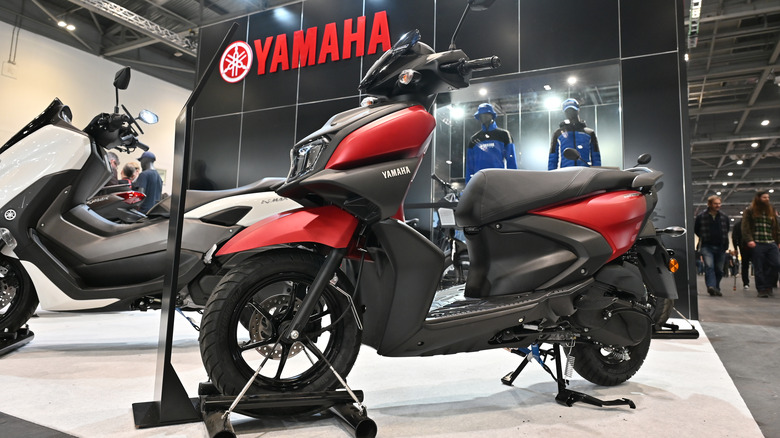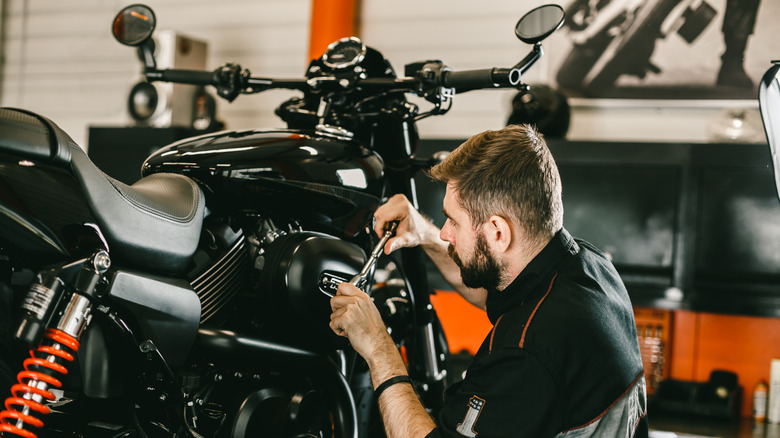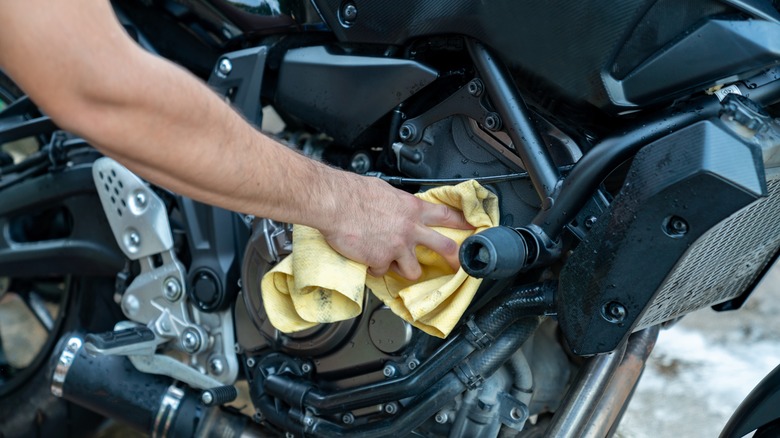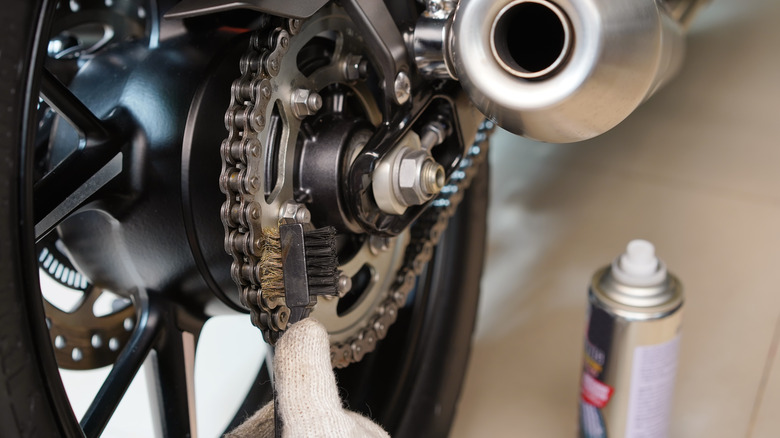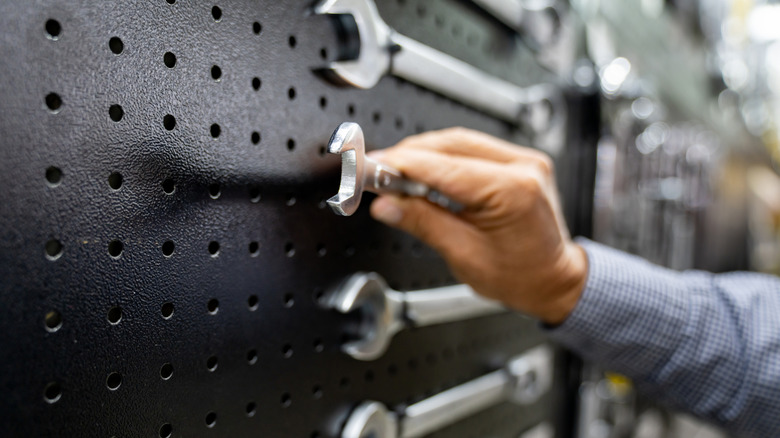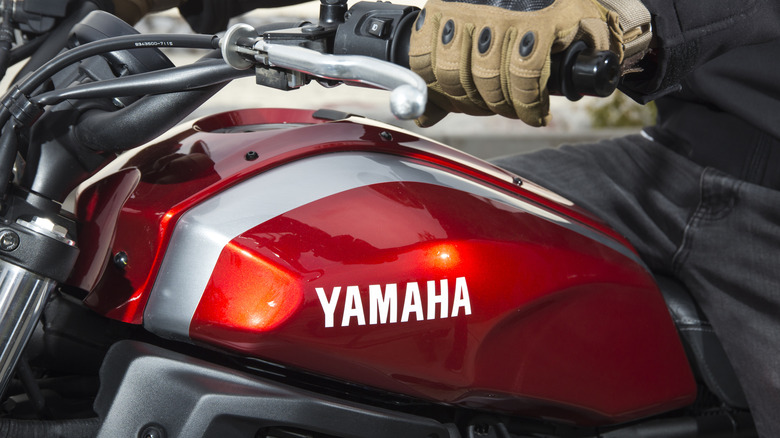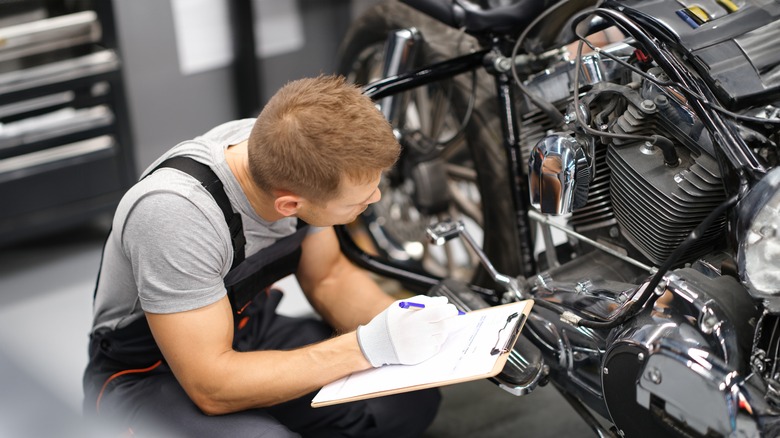5 Maintenance Must-Haves For Your Yamaha Motorcycle
We may receive a commission on purchases made from links.
Among motorcycle manufacturers out there, Yamaha is known to have some of the lowest maintenance costs in the market. However, their overall performance and reliability are still hinged on how well you drive on the road and how you care for them between rides. Because of this, if you want to avoid the dreaded death wobble on your Yamaha motorcycle, you'll need to commit to following a proper maintenance schedule.
While not everyone can always afford to send their motorcycle to the shop, especially if it has no obvious signs of issues, you can pick up the slack and learn how to care for your motorcycle by yourself. Aside from making sure it's clean, some other ways to care for your motorcycle include maintaining its chain, brakes, tires, and fluids. Not only can this save you money in the short term, but it can also help you spot any possible issues with your motorcycle before you get into any accidents.
Investing in tools that can help you do your regular maintenance safely and effectively is highly recommended. Depending on your lifestyle, climate, and driving, the exact tools you'll need to keep your Yamaha motorcycle running perfectly may vary. Lucky for you, we've rounded up a list of top recommendations consisting of the highly rated tools from Amazon and Harbor Freight, as well as hands-on experience from our team at SlashGear. You can read more about the methodology at the end of the article. Here's how to get started.
Wheel lift or stand
Before beginning to work on your motorcycle, one of the first things you should have is a wheel lift or stand. Although you can use hacks when parking your motorcycle on an ordinary day, it's ideal that you work with a proper stand for a variety of reasons. For example, this will not only make sure that your Yamaha motorcycle won't topple over, but it can also help keep your neck and back from hurting while working on your bike.
While there are hundreds of stands and lifts available on the market, you need to prioritize durability and stability. The wrong stand can have weak support or poor welding, which could lead to sudden breakage. In addition, cheaper stands made with inappropriate material may cause the bike to become outbalanced, especially if you sit on it or accidentally hit it.
To tell if a motorcycle stand or lift is of good quality, some qualities that you should definitely look for include a strong, solid base, ease of lifting, and adjustable height. If you have the budget and a heavy motorcycle, one of the most useful things you can buy from Harbor Freight is its Pittsburgh 1,000-pound Steel Motorcycle Lift, which sells for $549.99. With a hydraulic pump and diamond plate steel, this motorcycle lift has a welded steel frame that can bring your bike up to 29.5 inches of height, which puts it at a good level.
Cleaning spray
After you've got the right stand, the next thing on the agenda should be cleaning your Yamaha motorcycle. For example, one of the top-rated cleaner sprays for motorcycles on Amazon is the Chemical Guys Total Interior Cleaner and Protectant, which is available in 16-ounce, 128-ounce, and 1-gallon packs. With an average 4.6 rating from over 38,000 Amazon users, the Chemical Guys spray can also be used in your cars and motorcycles. Alternatively, you can buy the Muc-Off Nano-Tech Motorcycle Cleaner – 1-liter ($23), which has an average of 4.6 stars across over 5,000 reviews on Amazon. Using an alkaline-based formula, Muc-Off claims it is safe on all motorcycle surfaces, including its disc brake rotor and pad.
If you want an extensive set of motorcycle cleaning solutions, you can opt for the Muc-Off Ultimate Motorcycle Cleaning Kit ($106), which will include cleaning, protectant, and speed polish spray. Although if you've been using your Yamaha motorcycle on rough roads, WD-40 can work wonders to remove the tough solid particles, like dust and dirt, that may have gotten trapped in your chains, tires, and other parts of your bike.
Chain brush
Armed with the right cleaning spray, the next step is to find the right brush that you can use to get into the crevices of your Yamaha motorcycle that you might struggle to reach in other ways. Thankfully, you don't have to break the bank with a fancy brush to get the job done because you can use any nylon brush from an art supply or hardware store. If you're feeling extra stingy and have an old toothbrush you're not using anymore lying around, that might work, too. Unlike metal wire brushes, nylon brushes are known to be gentler and cause less damage to surfaces.
These days, you can get cleaning brush kits that work for your car, as well as your motorcycle. On Amazon, you can get this Car Detailing Kit ($35.99) with 27 pieces that include nylon brushes, plus a slew of sponges, towels, and applicators. However, if you want a brush set with various heads designed for bikes, you can get the Muc-Off 206 5-piece Premium Brush Kit ($38.56). With an average rating of 4.6 stars across 2,700+ Amazon reviews, the Muc-Off brush set already includes soft washing and detailing brushes.
If you want a brush set with a cleaning mitt and chain scrubber, you can get the Anndason 8 Pieces Precision Bicycle Cleaning Brush Tool ($15.99), which has an average rating of 4.3 stars out of over 4,100 reviews on Amazon, too.
Hand tools
Because Yamaha builds some pretty fast motorcycles, it's unsurprising that a few things can unceremoniously get loose or come off after a long ride. While some problems with your Yamaha might need professional help, some can definitely be fixed at home with the right tools. In general, you'll need wrenches, screwdrivers, and pliers in different sizes.
If you're on a budget and want some quality tools at a reasonable price point, you can snag a 130-Piece Pittsburgh Tool Set ($39.99). With an average rating of over 8,000 reviews on Harbor Freight, you get a pretty good bang for your buck for its brand and sturdy reputation. Although you might be tempted to buy the cheapest tools possible, remember that these carry some additional risk. For example, they might not fit well, align correctly, or break faster compared to tried and tested brands.
With the right tools, you can adjust the chain properly on your Yamaha motorcycle when you return it to avoid accidents. Afterward, if your budget still allows, you can invest in miscellaneous tools like toolboxes and a tool pack for your on-the-go needs. Not to mention, don't forget to follow this trick to keep track of your screws while you're working on your motorcycle to avoid losing them.
Tire pressure gauge and inflator
Because they're what separate you from the ground, keeping your motorcycle tires healthy is key to having a safe road driving experience. While some motorcycle tires are better than others, taking care of the ones you already have can make all the difference, and one way to do this is by monitoring their pressure. To do this, you might want to invest in a tire pressure gauge and inflator. A popular tire health gauge tool on Amazon is the AstroAI Tire Inflator Air Compressor ($35.99), with an average rating of 4.5 over 4,000 reviews, which you can use you can use on your car and bike.
If you do find issues with your tires, it may not be worth it to buy a motorcycle tire changer, especially if you're not confident in your ability to balance them. While it isn't impossible to do this at home, you'll likely need tools like a static balancing tool. Aside from a tire pressure gauge, you might also want to consider measuring tools like a spark plug tool and a multimeter that can help you properly evaluate your vehicle during maintenance.
Methodology
When it comes to maintaining any motorcycle, including a Yamaha motorcycle, the first line of defense is making sure that it is cleaned regularly. Because of this, this list includes the different highly rated basic cleaning materials and tools made specifically for motorcycle maintenance.
After cleaning, investing in tools that help you keep safe should be next on your list. From a good stand to make sure you're not squished by your bike while you're working on it, tools that won't break, and the right gauges, it's well worth the effort to make sure you don't get hurt in an accident (on and off your bike). Once you have all the necessary tools to get started, you might want to take note of our tips for motorcycle maintenance to help guide you.
If you're not a mechanic by profession, it is not always possible to know how to fix every possible problem that arises with your motorcycle. And even if you know enough to do some things here and there, you might not be able to resolve more serious issues at a degree that is safe. By having a regular and consistent maintenance schedule, you can build up a routine to slowly address the minor issues you can spot in between rides. It can also be a great way to spot potentially critical issues that require professional help.
